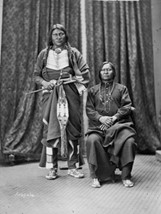 Indigenous Americans, including the Paleo-Indians, Ute, and Arapahoe, lived along the banks of the Cache la Poudre River for thousands of years. The Northern Arapaho tribe specifically used the region by the river for clan gatherings, ceremonies, and food gathering more than 100 years before European settlers made their way to the valley.
Indigenous Americans, including the Paleo-Indians, Ute, and Arapahoe, lived along the banks of the Cache la Poudre River for thousands of years. The Northern Arapaho tribe specifically used the region by the river for clan gatherings, ceremonies, and food gathering more than 100 years before European settlers made their way to the valley.
In 1868, the Federal government relocated the last Native Americans in the Poudre Basin to the Wind River Reservations in Wyoming. Forced relocation combined with other assimilation policies such as conversion to Christianity, boarding school restrictions, and the outlawing of Native American ceremonies resulted in a tremendous loss of cultural knowledge and traditions.
From an archaeologist’s perspective, the legacy of human presence in Northern Colorado exceeds more than 13,000 years of indigenous peoples living in and migrating through this unique eco-tone where the plains meet the mountains. From about 8,000 years ago, people hunted and gathered most of the animals and plants found today, with some minimal agricultural components.
Tribal groups as we know them today are not recognized as present until 1,000 A.D., if not longer, beginning with the Numic (Uto-Aztecan) speakers, commonly known as the Ute. Oral tradition and the ethnohistoric record show evidence of other tribal groups like the Apache, Comanche, Arapaho, Cheyenne, Kiowa, Lakota, Shoshone, and Pawnee in Colorado as early as the mid-17th century.
Compiled by Dr. Brenda Martin, Curator, Fort Collins Museum, May 2009



